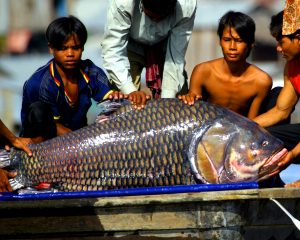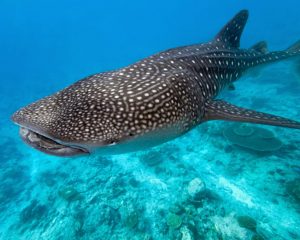The Mekong River Basin supports millions of people and some of the world’s richest biodiversity, but it must overcome many threats. This is the first story in a series I’ve been writing about the Mekong River, a research project led by Zeb Hogan.
This story was published by National Geographic on March 22, 2017. You can also read it here.
Phnom Penh, Cambodia — Zeb Hogan recalls the sense of wonder he felt when, as a fresh-eyed fish biologist, he first came to Southeast Asia some 20 years ago and encountered the Mekong River. Having grown up in the Arizona desert, where the rivers seldom held any water, let alone fish, it was quite the shock for the young Fulbright student to step into the most productive river system in the world.
“Everything was vivid and alive,” said Hogan. “It was like seeing the world through a new lens. The contrast with Arizona could hardly have been more extreme.”
His exchange program eventually ended, but Hogan was soon drawn back to the Mekong. Over the years, he spent more and more time in the region, immersing himself in the cultures of Thailand and Cambodia, two of the countries through which the Mekong River runs. Focusing his research on migratory fish, he became an expert on the endemic Mekong giant catfish, which holds the world record for the largest freshwater fish ever caught at 646 pounds (293 kilos).
Now, two decades later, Hogan, who is a National Geographic fellow and the host of the television show Monster Fish on Nat Geo Wild, is leading a new, five-year research project, supported by USAID, called “The Wonders of the Mekong,” which brings together a multi-disciplinary team of researchers in an effort to generate greater awareness of one of the most extraordinary ecosystems on Earth.
The project is starting at a time when the Mekong River Basin, which supports more than 60 million people, is undergoing huge transformation. While the river itself—long relatively untouched—is changing due to the building of dams, climate change, and habitat loss, larger economic and political forces are reshaping an entire region rich in culture and history.
“In my opinion, the Mekong River is the most important river in the world,” Hogan said, speaking ahead of the project launch in Phnom Penh, the Cambodian capital.
“But the Mekong River is now at a tipping point, where the choices made in the next 10 or 15 years could make or break the life it sustains.”
The Serpent of Southeast Asia
Originating high in the glaciated mountains of Tibet, the Mekong River is fed by the same headwaters that supply China’s Yangtze and Yellow Rivers. In China, the river is called Lancang, changing its name to the Mekong as it crosses into Laos and Myanmar.
It continues to flow through some of the most spectacular scenery in the world, including the forested mountains of the Golden Triangle, an area notorious for its opium production. For hundreds of miles, the river forms the border between Thailand and Laos. Later, in what may be its wildest stretch, it turns into a series of swirling rapids known as Khon Pi Long, or “where the ghost lost its way,” passing through an archipelago of 4,000 islands, many of them dotted with temples and shrines, as well as the world’s widest waterfall, before finally leaving Laos and dropping into Cambodia.
There, it forms deep pools sheltering the world’s largest freshwater fish before running into the vast flood plains and flooded forest that drive much of the region’s productivity. It is joined by a tributary that changes direction every year and connects it with Tonle Sap Lake, Southeast Asia’s largest inland lake and “the beating heart of Cambodia.” Later, in Vietnam, it runs through rice plantations with a special breed of floating rice growing meters tall in pace with rising floodwaters, before splitting into nine branches known as “the nine dragons,” and eventually disgorging into the South China Sea.
“The Mekong and associated tributaries are wonderfully large, interconnecting with their landscape during wet season and retreating into their channels during the dry season,” said Sudeep Chandra, director of the University of Nevada Global Water Center, which is coordinating the research.
“The scale of this connection in the Mekong is like no other, as evidenced by the vast amount of biodiversity and production of fishes that comes out of the system annually,” he added.
World’s Biggest Inland Fishery
The Greater Mekong region is in fact one of the most biodiverse areas in the world. It contains no fewer than 20,000 species of plants, 1,200 bird species, 800 kinds of reptiles and amphibians, and 430 species of mammals, including Indochinese tigers, Asian elephants, and the critically endangered Irrawaddy dolphins.
The river itself supports almost 1,000 different species of fish, ranking it second only to the Amazon in terms of fish diversity. It also has more giant fish than any other river on Earth, from giant freshwater stingrays to 500-pound carp.
“The Mekong River is heaven for a fish biologist,” said Hogan. “It is superlative in every way. But it is also a region at risk.
“Cambodia is a last refuge for biodiversity teetering on a knife’s edge, and many of the largest, most iconic animals are on the brink of extinction.”
In part for that reason, the project headquarters will be in Phnom Penh. Of all the countries connected to the Mekong, none is more closely intertwined with the river than Cambodia, sitting as it does at the heart of the largest inland fishery in the world. According to some estimates, the Mekong River Basin produces more than three million tons of fish a year, accounting for an astonishing quarter of the global freshwater catch.
Its fertile delta also helps to feed the world’s growing appetite for rice. In 2014, Cambodia and the other lower Mekong countries produced more than 100 million tons of rice, around 15 percent of the world’s total. The endless rice plantations seen throughout central Cambodia depend on the nutrient-rich sediments that the Mekong carries downriver, mainly during the rainy season from June to October.
Indeed, what happens at one end of the Mekong River has a strong impact on what goes on in another. Experts are particularly fearful that the construction of a series of dams in Laos and other areas in the upper reaches of the Mekong River and its tributaries will destroy crucial habitat for migrating fish and could ultimately lead to the extinction of many vulnerable fish species, such as the critically endangered “giant pangasius,” a predatory species also known as the “dog-eating” catfish that can grow up to 10 feet long.
From Holistic Science to Sustainable Economics
While economic growth has steadily increased in the region, many of the countries remain mired in poverty. Economic pressures, including the demand for land for industrial agriculture, the unsustainable harvesting of not only fish but also high-value timber, and the impact of rapid urbanization, are intensifying.
“We have to recognize the need for economic growth,” says Hogan. “Development and conservation must work in tandem. It can’t be an either-or proposition.”
Almost as striking as its biodiversity is the Mekong region’s cultural diversity. There are more than 300 million people from nearly 100 distinct ethnic groups living in the Greater Mekong area. It also has a rich cultural and historical heritage. It is home to the northern Lao city of Luang Prabang, an epicenter of the Buddhist faith, as well as the ancient cities of the Angkor empire, the biggest urban complex of the preindustrial world.
“The goal of this project is to meld an understanding of the current science on biodiversity, climate, and hydrology of the Mekong River Basin with a historical and archaeological understanding of this system to point toward a sustainable future,” said Hogan.
“Given the importance of a healthy, connected Mekong to people, fish, and wildlife, the decisions made today are critical to the future of the region.”

